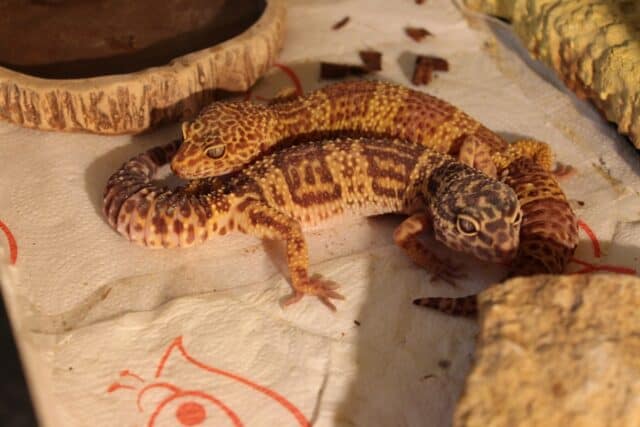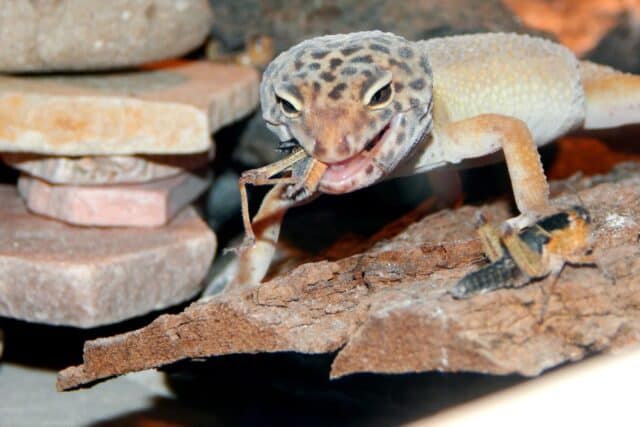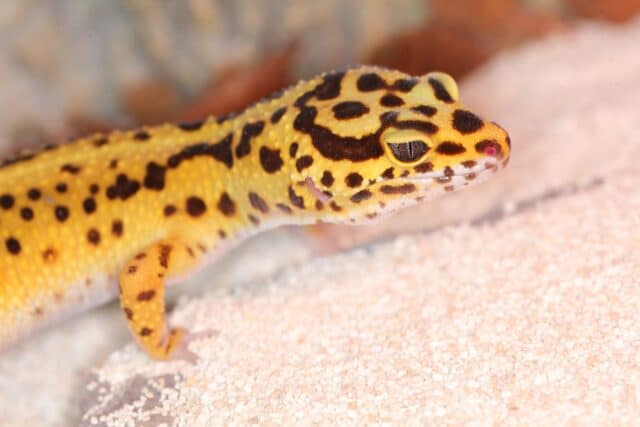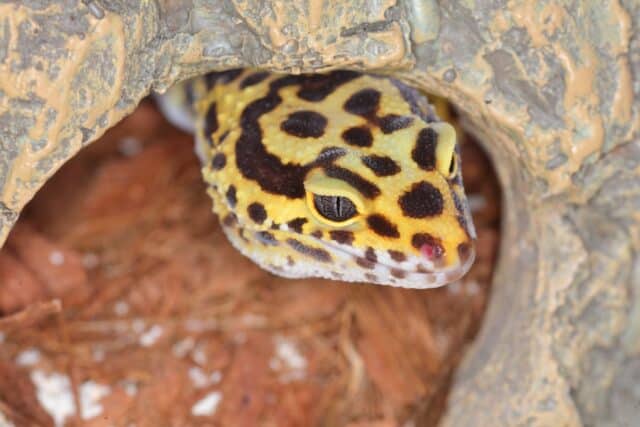Leopard geckos, with their captivating patterns and gentle nature, have cemented their place in the hearts of reptile enthusiasts. But beyond their aesthetic appeal lies a world of behaviors and quirks waiting to be understood.
By diving deep into the realm of leopard gecko behavior, from their intriguing body language to the reasons behind their glass surfing, pet owners can foster a deeper bond and ensure the well-being of their scaly companions.
Leopard Gecko Behavior
To many, a reptile’s behavior might seem straightforward or even mundane, but leopard geckos tell a different story. These creatures, native to the rocky desert terrains of Afghanistan, Pakistan, and India, have evolved with a plethora of behaviors, each revealing a fragment of their unique personality and instinctual drives.
Understanding the behavior of your leopard gecko isn’t just about decoding what they do; it’s about deepening your connection, optimizing their living conditions, and ensuring their well-being. Recognizing the signs of a stressed or contented gecko can be the difference between a thriving pet and one that struggles.
Moreover, for potential owners, having an insight into their future pet’s behavior can set the stage for years of harmonious coexistence.
The Basics of Leopard Gecko Behavior
The leopard gecko, with its distinctive patterns and calm demeanor (they’re generally quiet), carries with it a tapestry of behaviors rooted deeply in its evolution and natural habitat. To truly appreciate and care for these reptiles, it’s essential to understand the basics that drive their daily actions and reactions.
Natural Habitat Influence: Originating from the arid terrains of South Asia, leopard geckos have evolved behaviors suited for survival in such environments. Their nocturnal nature, for instance, isn’t merely a quirk—it’s an adaptation. By staying active during the cooler nights, they avoid the scorching daytime temperatures, conserving energy and moisture.
Evolutionary Traits: Over millions of years, evolution has shaped leopard geckos to be adept survivors. They’ve developed keen instincts that govern their habits, such as seeking shelter during the day or marking their territory. Their territorial nature especially stands out. While generally calm, these reptiles can become assertive, particularly when they feel their domain is being challenged.
Natural Instincts: Deep-seated in their DNA are behaviors that even captivity cannot erase. They’ll often exhibit habits stemming from their wild counterparts, like hunting their food with precision or cautiously exploring new environments, a testament to their natural instincts. You can even see them digging when they’re getting ready to lay eggs.
Interpreting their Body Language
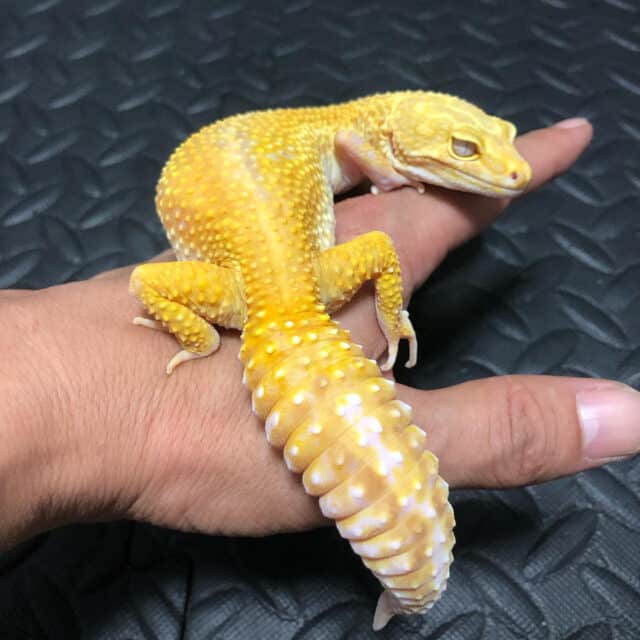
Leopard geckos, though they might not possess the vocal range of other pets, are master communicators in their own right. Their body language is a rich tapestry of cues, each gesture conveying a unique message, whether it’s a feeling of contentment, curiosity, or caution. However, keep in mind that their smiles are not going to express the same things that humans feel, they’re more of an illusion.
Tail Movements: One of the most expressive parts of a leopard gecko is its tail. When a leopard gecko wags its tail, it’s not merely playing—it’s communicating. Tail wagging can be a sign of excitement, especially during hunting. However, if the tail is raised and twitching, it can indicate agitation or a warning to potential threats. Understanding these gecko tail signals is crucial for interpreting their mood and ensuring their comfort.
Eye Behavior: The eyes of a leopard gecko can reveal much about its state of mind. Blinking patterns, for example, are more than just a simple reflex. Slow blinking can be a sign of relaxation, while rapid blinking might suggest irritation, possibly due to dust or other irritants. Moreover, a gecko that frequently closes its eyes or squints in a well-lit environment may be signaling discomfort or stress.
Communication through Gestures: Beyond the tail and eyes, leopard geckos use various gestures to convey messages. For instance, a gecko might arch its back when threatened or wave its legs as a sign of submission. Recognizing these nuanced gecko gestures helps in gauging their comfort levels and adjusting their environment accordingly.
Common Behaviors Explained
While leopard geckos are popular pets, they come with a suite of behaviors that might initially baffle, intrigue, or even worry their owners. These reptiles, with their prehistoric origins and unique adaptations, express themselves in ways that are sometimes starkly different from our furry or feathery companions. However, each behavior, no matter how odd it may seem at first glance, has a purpose and an underlying reason.
Leopard Gecko Glass Surfing and its Meaning
One behavior that often catches leopard gecko owners off guard is the act of glass surfing. This action, where the gecko appears to be “scrabbling” or “climbing” the glass walls of its enclosure without making upward progress, can be puzzling and even concerning. But what does it truly signify?
Stress Indicators: Glass surfing is often a manifestation of stress or discomfort. Just as we might pace back and forth when anxious, leopard geckos might surf the glass to communicate their unease. It’s essential to identify potential stressors, as prolonged stress can impact their overall health.
Terrarium Setup: The environment within the tank plays a pivotal role in determining a gecko’s comfort. If the terrarium is too small or lacks adequate hiding spots, the gecko might feel exposed and vulnerable, prompting them to surf the glass. A misbalanced temperature gradient or inappropriate substrate can also be culprits. Reevaluating and optimizing the tank setup can alleviate this behavior.
Territorial Challenges: Leopard geckos are territorial by nature. If they sense another gecko or even see their reflection in the glass, they might interpret it as an intrusion into their territory. They don’t get lonely and they prefer not having other Leos around. Ensuring that the tank’s placement doesn’t cause reflections and keeping geckos separately can help in reducing territorial glass surfing.
Exploration and Curiosity: Sometimes, glass surfing isn’t a sign of distress but simply a manifestation of their natural curiosity. Leopard geckos, especially younger ones, are explorative and might be trying to understand their boundaries.
The Truth Behind Leopard Gecko Bites
It’s a scenario many leopard gecko owners dread: opening the tank and suddenly feeling a nip on their fingers. Though these reptiles are generally docile, bites can occasionally occur. But why? And should owners be genuinely concerned?
Factors Triggering Bites: Several triggers can lead to a leopard gecko biting. One common reason is mistaking fingers for food, especially during feeding times. If an owner’s fingers have remnants of the gecko’s meal or if the gecko is particularly hungry, it might nip thinking it’s getting a treat. Other times, stress may be an issue, and screaming can be something you notice beforehand.
Feeding Time Caution: It’s essential to be cautious during feeding times. Using feeding tongs or ensuring one’s hands don’t smell like their food can minimize the risk. Also, regular feeding schedules can reduce the odds of hunger-induced nips.
Handling Frequency and Comfort: How often and how a gecko is handled can influence its behavior. New or young geckos might be more nervous and prone to biting out of fear. Gradually acclimating them to handling, always approaching them gently, and avoiding sudden movements can foster trust and reduce bite incidents.
Bite Intensity: The good news is, while a leopard gecko bite might be surprising, it’s rarely harmful. These reptiles don’t have the jaw strength of larger creatures, and while a bite might cause minor discomfort, it’s unlikely to cause significant injury.
Reading the Signs: Often, a bite doesn’t come out of the blue. By paying attention to body cues like an arched back, a raised tail, or widened eyes, owners can gauge a gecko’s mood and anticipate aggressive behavior.
How The Leopard Gecko’s Behavior Changes with Age
From the tiniest of hatchlings to the wise old adults, a leopard gecko’s journey through life is punctuated by numerous behavioral shifts. Just as humans exhibit different preferences, reactions, and habits at various life stages, so do these reptiles.
As they transition from the playful and explorative days of youth to the more sedate and established routines of adulthood, owners might notice various changes in their behavior.
Juvenile Behavior Peculiarities
Juvenile leopard geckos—those little bundles of energy—are a delightful mix of curiosity and dynamism. Their actions, driven by their nascent understanding of the world around them and their ongoing growth phases, differ significantly from their adult counterparts. Whether it’s their relentless exploration or their frequent shedding, juvenile geckos bring with them a set of unique behaviors.
Growth Phases Impact: Growing at a rapid pace, young geckos have specific needs that influence their actions. One evident sign of this growth is their frequent shedding. Unlike adults who shed less often, juveniles may shed every few weeks, making it essential for owners to ensure a moist environment to aid this process.
Boundless Curiosity: The world is a vast, uncharted territory for baby geckos. Their explorative nature is on full display as they scuttle around, climbing, investigating, and even occasionally tasting everything in sight. This intrinsic curiosity, while endearing, also means that their habitat should be free of potential hazards.
Social Interactions: Juvenile geckos are still learning the ropes when it comes to social interactions. While they might exhibit playful behaviors, they can also be skittish and more prone to stress. Gentle handling and gradual acclimatization to their surroundings can go a long way in making them feel secure.
Feeding Quirks: Baby gecko behavior around food can be both amusing and challenging. Their voracious appetite means they’ll eagerly chase after their meals, but they might also be more finicky about food choices. It’s a dance of trial and error to figure out their favorites.
Sleep Patterns: Young geckos, much like human babies, might have irregular sleep patterns. Though they are fundamentally nocturnal, don’t be surprised to catch them active at odd hours, exploring or hunting.
Adult Gecko Behavioral Traits
Transitioning from the spirited days of youth, adult leopard geckos present a calmer, more established set of behaviors. The frenetic energy of juvenility gives way to a more predictable and settled routine. However, this stage brings its own set of unique actions and behaviors, many of which are tied to their mature status, breeding instincts, and territorial nature.
Settling Down: One of the most noticeable shifts in behavior is the reduced frenzy in their daily activities. Mature geckos tend to have established favorite spots in their terrarium, preferred hiding places, and even set paths they like to traverse. This predictability can be a relief for many owners, making care routines more straightforward.
Breeding Behaviors: As they reach sexual maturity, leopard geckos begin to exhibit breeding-related actions. This can include everything from mating calls—a series of chirps and clicks—to more pronounced territorial behaviors. Males, especially, might become more aggressive during breeding seasons, defending their territory and seeking mates.
Territory Marking: Adult geckos, particularly males, are more territorial than their younger counterparts. This can manifest in behaviors like scent marking, where they rub their bodies against surfaces to lay down their scent, signaling their claim on the area.
Dietary Changes: While the juvenile stage is characterized by rapid growth and a consequent high metabolic rate, adults tend to eat less frequently. Owners might notice their gecko’s appetite tapering off, with a preference for larger, more filling meals rather than frequent small feeds.
Response to Handling: Mature geckos, having been handled over time, are generally more docile and tolerant of human interaction. They are less skittish and more amenable to being picked up, though individual personalities always play a role. You can try to teach them leash training long before that, though.
Health Monitoring: Age-related actions in geckos also encompass signs that it might be time for a health check. Slower movements, reduced appetite, or even changes in shedding patterns can be indicative of underlying health concerns.
Unique Behaviors Worth Noting
Leopard geckos, with their captivating personalities, are not just about the usual basking, feeding, or mating rituals. Hidden beneath these routine behaviors are a series of actions that might seem odd, perplexing, or even amusing to the casual observer. However, each of these unique behaviors carries with it a tale of evolution, instinct, or adaptation.
Shedding Rituals in Leopard Geckos
Shedding, also known as molting, is a fascinating and vital process for leopard geckos. This act of periodically discarding the old skin to make way for new growth is not only a sign of a healthy gecko but also an evolutionary marvel. The entire shedding ritual is rich in nuances, underscoring the intricate balance between the gecko’s biology and its environment.
Frequency of Shedding: While juveniles shed more frequently due to their rapid growth, adult geckos also undergo this ritual, albeit less often. Depending on factors like age, health, and diet, shedding can occur every few weeks to every few months.
The Process Itself: The shedding process is initiated when the gecko’s outer skin layer becomes loose. This is followed by a slightly opaque or dull appearance, signaling that shedding is imminent. Over the next few hours to days, the old skin detaches, revealing the fresh layer beneath.
Skin Health: Shedding is an essential process for maintaining skin health. As the gecko grows, the older skin can become restrictive. Molting ensures the skin remains flexible and comfortable. Moreover, the new skin is better suited to protect the gecko from potential injuries or infections.
Moisture Needs: A crucial aspect of the shedding process is the need for humidity. Leopard geckos originate from arid environments but require moisture to shed effectively. In captivity, it’s essential to provide a moist hide or regularly mist the terrarium during shedding times to facilitate the process.
Consuming The Shed: One behavior that often surprises first-time gecko owners is witnessing their pet consume the shed skin. This is not an act of cleanliness but a way to reclaim vital nutrients, especially calcium, from the old skin.
Shedding Challenges: Occasionally, geckos might face difficulties in shedding, leading to remnants of skin clinging, especially around sensitive areas like the eyes or toes. Regular monitoring and assisting in gentle removal (if required) can prevent complications.
Vocalizations and Their Meanings
While leopard geckos might not be the most vocal reptiles, they surely are communicative in their unique way. Relying on an assortment of chirps, clicks, squeaks, and even growls, these reptiles have developed a language of sounds that convey their emotions, needs, and interactions. Whether expressing discomfort, signaling a mating call, or merely communicating with their fellow geckos, understanding these vocalizations can offer owners a deeper connection with their pets.
Types of Sounds: Leopard geckos have a range of vocalizations, each with its distinct tone and frequency. The most common are chirps and clicks, but attentive owners might also discern squeaks, hisses, and occasional growls.
Distress Calls: A sudden, sharp squeak or hiss usually indicates discomfort or distress. This could be due to an unexpected disturbance, an unfavorable environment (maybe your first attempt at placing the gecko on your shoulder), or even potential threats from other animals. It’s essential to check on your gecko if you hear these sounds regularly.
Mating Chirps: During the breeding season, leopard geckos become more vocal. Males, in particular, emit a series of chirps and clicks, signaling their readiness to mate. These calls not only attract potential mates but also establish their presence among other rival males.
Social Interactions: In a multi-gecko habitat, vocalizations play a significant role in establishing hierarchy and territories. A dominant gecko might growl or hiss to ward off intruders or establish its claim over a particular spot.
Expressing Needs: Sometimes, geckos vocalize to convey their needs. A soft chirp might indicate hunger, a desire for attention, or even a change in their habitat’s conditions, like temperature or humidity (some misting may be required).
Understanding Context: While vocalizations offer clues, it’s crucial to consider the context. For instance, a chirp during feeding might be an expression of excitement, while the same sound at night could be a mating call. When a leo licks you can also mean different things.
Conclusion
The world of leopard geckos is teeming with intricate behaviors, subtle gestures, and a symphony of sounds that might initially seem alien to many.
But as we’ve journeyed through their behavioral patterns, from their basic instincts rooted in evolution to their unique actions and vocalizations, it’s clear that these reptiles are more than just passive pets.
They’re sentient beings, each with their personalities, preferences, and ways of communication.
FAQs
Why is my leopard gecko wagging its tail?
Tail wagging can signify several emotions in leopard geckos. A slow, deliberate wag often indicates curiosity or interest, especially during feeding or exploration. However, a rapid, aggressive tail wiggle might be a sign of agitation or a warning signal to other geckos or potential threats.
What does it mean when my gecko licks its lips or eyes?
Leopard geckos have no eyelids, so they regularly lick their eyes to keep them clean and moist. Licking their lips can be an instinctual behavior after eating or a way to explore their environment, as they have a Jacobson’s organ in their mouth that aids in sensing their surroundings.
Why does my leopard gecko stare or seem to be in a trance?
Geckos, like many reptiles, can enter a state of minimal activity where they seem to be zoning out or staring into space. This behavior is entirely normal and can be a resting phase or a period of focused attention, especially if something has caught their interest.
Is it typical for geckos to hide for extended periods?
Absolutely. Leopard geckos are nocturnal by nature, and they prefer hiding during the day in burrows or shaded areas. In captivity, providing them with hideouts is essential. If your gecko is hiding more than usual, it could be due to stress, shedding, or feeling unwell, so it’s good to monitor and ensure the habitat conditions are optimal.
Can leopard geckos recognize their owners?
While reptiles don’t have the same emotional capacity as mammals, there’s evidence to suggest that leopard geckos can recognize and become familiar with their owners. This recognition is more based on association (like associating their owner with food) rather than emotional bonding. Over time, with regular, gentle handling, many geckos become more docile and receptive to their human caregivers.
